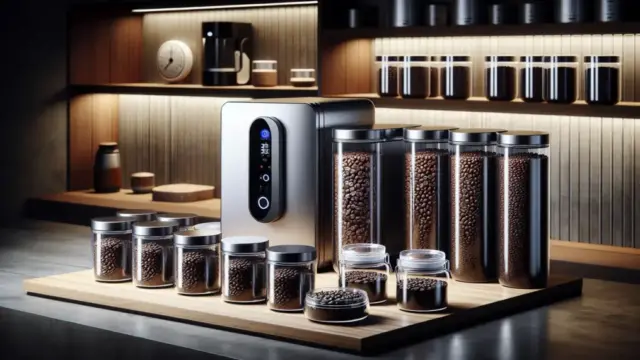For coffee lovers, maintaining the freshness of coffee beans is crucial. But what’s the best way to store them for the long term? Freezing is a popular method for many, but without the right knowledge, it can actually compromise the flavor. In this article, we’ll dive into the best practices for freezing coffee beans, how long they can be stored, and share tips to ensure they stay fresh.
Learning the proper storage techniques is essential to enhance your coffee experience. By understanding the pros and cons of freezing, as well as the optimal storage duration, you can savor your daily brew even more. So, let’s embark on a deep exploration of the coffee world together.
- Introduction to basic coffee bean storage methods and options
- Understanding the benefits and drawbacks of freezing
- Explanation of the optimal freezing duration and changes in flavor
How to Store Coffee Beans and Why It Matters
The way you store coffee beans is crucial for maintaining their flavor and aroma. To truly enjoy fresh coffee, it’s essential to choose the right storage method. The freshness of the beans can vary significantly based on their condition and the environment they’re kept in, so understanding different storage options—like freezing—is key. In this section, we’ll delve into the basics of keeping your coffee fresh and explore specific storage methods you can use.
Basics of Keeping Coffee Fresh
Coffee beans oxidize over time, leading to a loss of flavor. To maintain their freshness, start by storing the beans in a cool, dark place, away from moisture and heat. It’s also important to use them as quickly as possible once opened. Roasted beans, in particular, are sensitive to freshness, so proper storage right after purchase is vital.
You can also enhance freshness by getting creative with your storage techniques. For instance, using an airtight container to limit exposure to air or incorporating freezing methods can significantly extend the beans’ freshness. By following these guidelines, you’ll be well on your way to enjoying all the rich flavors coffee has to offer.
- Coffee beans oxidize quickly, so using them sooner is important.
- Store them in a cool, dark place to avoid moisture and heat.
- Utilize airtight containers or freezing techniques to keep them fresh.
Storage Options
When it comes to storing coffee beans, you have several options. Generally, the three main methods are room temperature storage, refrigeration, and freezing. For room temperature storage, it’s best to keep the beans in an airtight container in a cool place. This method is convenient but not ideal for long-term storage.
Refrigeration involves keeping the beans in the fridge to avoid moisture. However, be cautious—humidity and odors in the fridge can negatively affect the beans. On the other hand, freezing is one of the most effective methods for preserving flavor. If you choose to freeze, it’s recommended to portion out the beans, so you only take out what you need.
Each storage method has its own pros and cons, so it’s important to choose one that fits your lifestyle and preferences. By finding the right way to maintain your beans’ freshness, you’ll set the stage for an even more enjoyable coffee experience.
- Room temperature storage is convenient but not suitable for long-term use.
- Refrigeration can lead to moisture issues.
- Freezing is effective and can preserve flavor if done correctly.
The Pros and Cons of Freezing Coffee Beans
Freezing coffee beans is a popular method for preserving freshness, but to truly harness its benefits, it’s essential to grasp the scientific principles behind freezing and the precautions that come with it. In this section, we’ll delve into the advantages and disadvantages of freezing coffee beans, exploring how to handle them properly. With the right knowledge, you can keep your coffee’s flavor intact while extending its shelf life.
The Science Behind Freezing
The effectiveness of freezing coffee beans lies in the fact that lower temperatures slow down oxidation reactions. Oxidation is a primary culprit that degrades the flavor of the beans, especially in those roasted beans that are prone to rapid oxidation. When you freeze the beans, ice crystals form on their surface, acting as a barrier against oxygen and moisture, which helps maintain freshness.
However, there are important considerations to keep in mind when freezing coffee. Before you put the beans in the freezer, it’s crucial to portion them out and store them in airtight containers. This practice minimizes the impact of temperature fluctuations and moisture from opening and closing the freezer door. By properly freezing your beans, you can effectively maintain their freshness over an extended period.
- Freezing slows oxidation and helps preserve flavor
- Ice crystals on the beans block oxygen and moisture
- Portioning and sealing the beans in airtight containers is essential
Understanding the Downsides
While freezing has its benefits, there are also some downsides to consider. One significant issue is that when you thaw frozen beans, their flavor may temporarily diminish. Rapid temperature changes can stress the beans, affecting their aroma and taste. To minimize this, it’s best to take the beans out of the freezer and allow them to return to room temperature slowly.
Additionally, not all beans are suitable for freezing. For instance, freezing already opened or stale beans won’t yield any benefits. Freezing is only effective for beans that are in good condition. Understanding these factors is crucial for making informed decisions about freezing your coffee beans.

If you found this article interesting, you might also enjoy reading “How to Properly Thaw Frozen Coffee Beans and Its Effects Explained!”. This piece offers detailed insights on the precautions of freezing and key points for thawing, filled with valuable information to help you maintain your coffee’s flavor. Be sure to check it out!
- Thawing frozen beans can lead to a temporary loss of flavor
- Rapid temperature changes can stress the beans
- Opened or stale beans are not suitable for freezing
The Ideal Duration for Freezing Coffee Beans
Freezing coffee beans is an effective way to maintain their freshness, but knowing the right storage duration is equally important. In this section, we’ll delve into recommended freezing periods and discuss how the flavor of coffee can be affected after storage. Understanding the optimal duration lays the groundwork for achieving the best coffee experience.
Recommended Freezing Duration
When it comes to freezing coffee beans, the typical guideline is to keep them in the freezer for about one to three months. During this time frame, the beans can retain their flavor and aroma quite well. However, factors like freezer temperature and storage conditions can alter this timeline, so it’s important to check these details thoroughly before freezing your beans.
To minimize the impact of temperature fluctuations and frequent opening and closing of the freezer, it’s advisable to store the beans in small portions. This method allows you to take out only what you need, keeping the remaining beans fresh in the freezer.
- Recommended freezing duration is about one to three months
- Duration can vary based on temperature and storage conditions
- Storing in small portions helps maintain freshness
Flavor Changes After Freezing
What happens to the flavor of coffee beans once they’ve been frozen and then thawed? If done properly, freezing can minimize flavor loss, but care must be taken during the thawing process. Sudden temperature changes can damage the beans, so it’s crucial to allow them to thaw at room temperature after taking them out of the freezer.
The flavor of coffee after storage can also vary based on the roasting method and the type of beans. Beans with robust flavors can maintain their characteristics through freezing, while lighter-flavored beans may be more susceptible to changes. Choose your storage methods according to the specific qualities of the beans to ensure the best coffee experience.
- Caution is needed during temperature changes when thawing
- Thawing at room temperature is recommended
- Flavor changes may vary depending on the type of beans
Real Experiences and Recommended Storage Techniques
When it comes to freezing coffee beans, combining theory with personal experience can lead to more effective methods. In this section, I’ll share my own journey with freezing coffee beans, along with my top recommendations for storage containers and techniques. I hope that by learning some practical tips, you can enhance your coffee experience.
My Freezing Experience
The first time I froze coffee beans was when my go-to beans were suddenly out of stock. To bridge the gap until I could buy new ones, I decided to give freezing a shot. I portioned the beans into smaller amounts, placed them in resealable bags, and tossed them in the freezer. Initially, I was a bit apprehensive, but I was pleasantly surprised by how well the flavor held up after thawing, so I’ve continued to use this method since then.
When freezing coffee, it’s crucial to remove as much air as possible to seal the bags tightly. The first time I tried this, I left a bit of air inside, which compromised the flavor. Since then, I’ve made it a point to ensure that the bags are vacuum-sealed before putting them away. This experience made me realize just how much proper storage can affect the quality of coffee.
- My first freezing experience yielded surprisingly good flavor
- Removing air and sealing tightly is essential
- I learned how storage methods impact coffee quality
Recommended Storage Containers and Methods
For freezing coffee beans, I highly recommend using vacuum-sealable bags or containers. These options effectively block out air, protecting the beans from moisture and oxidation. If you have a vacuum sealer, it can make a significant difference in maintaining freshness.
Additionally, to keep the temperature stable in your freezer, it’s best to store the beans towards the back. If you place them in a frequently opened section, the temperature fluctuations can shorten their shelf life. When you need to take some beans out, only grab what you need and return the rest to the freezer right away. This helps prevent flavor degradation.
- Vacuum-sealable bags or containers are ideal
- Using a vacuum sealer enhances effectiveness
- Storing towards the back of the freezer minimizes temperature changes
Conclusion
Freezing coffee beans is an effective way to maintain their freshness, and with the right knowledge, you can enjoy their flavor for an extended period. Choosing the appropriate method based on the condition of the beans and the storage environment is crucial for keeping them fresh. Additionally, understanding the recommended freezing duration and the tips for thawing can enhance your coffee experience.
I encourage you to take inspiration from my personal experiences and recommended storage techniques to enrich your coffee life at home. When you purchase new beans, it’s a great opportunity to reassess your storage methods. I hope your coffee moments become even more enjoyable and fulfilling.
- Freezing coffee beans can help extend their freshness.
- The recommended storage duration is about one to three months.
- Removing air and sealing them tightly is key to preserving flavor.
Take this chance to find a storage method that works for you and enjoy delicious coffee. I’d love to hear about your experiences or any questions you might have in the comments section!











































































Comment